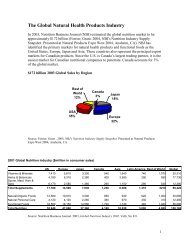Beyond Borders: Global biotechnology report 2010
Beyond Borders: Global biotechnology report 2010
Beyond Borders: Global biotechnology report 2010
You also want an ePaper? Increase the reach of your titles
YUMPU automatically turns print PDFs into web optimized ePapers that Google loves.
partnering in the pre-competitive space,<br />
for instance, where it makes sense to pool<br />
resources and tackle early-stage scientific<br />
challenges. One prominent example, Enlight<br />
Biosciences, is discussed in some detail<br />
in last year’s <strong>Beyond</strong> borders. Eli Lilly has<br />
launched its PD 2 initiative to attract early<br />
intellectual property (IP) from academia. In<br />
2009, we also saw GlaxoSmithKline open<br />
much of its IP portfolio in neglected diseases<br />
and invite other companies to follow suit (as<br />
Alnylam did in July 2009). We don’t expect<br />
such open innovation approaches to account<br />
for the vast majority of biopharmaceutical<br />
R&D, but it will be an important presence<br />
in certain niche areas — primarily in early<br />
research and preclinical development.<br />
Payors and governments<br />
In recent years, biotech and pharma<br />
companies have faced growing pricing<br />
pressure from governments and<br />
private-sector payors. The drivers of<br />
this trend — rapidly growing health care<br />
costs, the desire to expand access to a<br />
greater percentage of the citizenry and<br />
aging populations — continue unabated,<br />
and as a result, pricing pressures are<br />
expected only to grow over time.<br />
The global recession has further increased<br />
the budgetary pressures on governments.<br />
Tax revenues have plummeted with the<br />
downturn in economic activity, while<br />
policy-makers have had to boost spending<br />
on stimulus packages and unemployment<br />
benefits. In the US market, where health<br />
insurance coverage is largely tied to<br />
employment status, widespread layoffs have<br />
dramatically increased the number of people<br />
at risk of losing access to health care.<br />
Meanwhile, the rules of the game are<br />
changing. Over the last year, significant<br />
health care reforms have been introduced<br />
in some key pharmaceutical markets, the<br />
most prominent among which are the US<br />
and China. These reform measures — which<br />
promise over time to redraw the competitive<br />
landscape, revise rules and regulations<br />
and reorder economic incentives — are<br />
largely attempts to find more sustainable<br />
ways of providing health care in response<br />
to the pressures mentioned above. Not<br />
surprisingly, similar measures are being<br />
considered or enacted across a number of<br />
other major developing markets as well,<br />
from Brazil to Russia to India.<br />
Sweeping changes to health care systems<br />
will, almost inevitably, create new<br />
opportunities and challenges for biotech<br />
and pharma companies. (See A closer<br />
look on the next page for more on the<br />
implications of the recently passed US<br />
legislation.) One of the biggest challenges<br />
may come from the increased adoption<br />
of comparative effectiveness measures.<br />
The fact that many health care reform<br />
efforts need to reconcile two somewhat<br />
contradictory goals — expanding<br />
access to health care while containing costs<br />
— will require increased efficiency across<br />
the health care ecosystem and<br />
will likely increase the adoption of<br />
comparative-effectiveness regimes.<br />
While they have become fairly<br />
commonplace in some European markets,<br />
comparative-effectiveness systems — in<br />
which reimbursement decisions are based<br />
not just on the efficacy of a particular<br />
treatment but on the incremental benefit<br />
it provides relative to cost — have been<br />
largely absent from the US health care<br />
system. That may not change dramatically<br />
in the immediate future; while the new US<br />
legislation provides funding for comparativeeffectiveness<br />
research, it also explicitly<br />
prohibits government payors from making<br />
coverage decisions based on the findings.<br />
Still, the provision is widely viewed as<br />
potentially setting the stage for wider use<br />
of comparative-effectiveness findings in<br />
the US market going forward. Meanwhile,<br />
the significant increase in coverage under<br />
the new law will only increase the need to<br />
control costs — making the future adoption<br />
of comparative-effectiveness considerations<br />
ever more likely. To some extent, the moveto<br />
comparative effectiveness is likely to proceed<br />
regardless of the actions of government<br />
payors. The increased use of health IT,<br />
for instance, will permit anyone with access<br />
to significant volumes of data — hospital<br />
systems, insurance companies and others —<br />
to use data mining to identify which patient<br />
populations a certain treatment is most<br />
effective on. (For examples of such initiatives,<br />
see the <strong>2010</strong> issue of Progressions.)<br />
continued on page 13<br />
“The fact that many health care reform<br />
efforts need to reconcile two somewhat<br />
contradictory goals — expanding access<br />
to health care while containing costs — will<br />
require increased efficiency across the<br />
health care ecosystem and will likely<br />
increasing the adoption of comparativeeffectiveness<br />
regimes.”<br />
11








